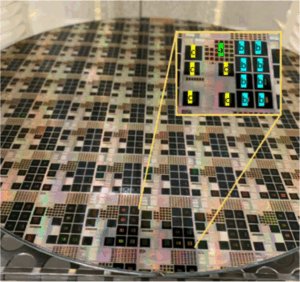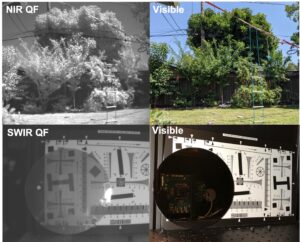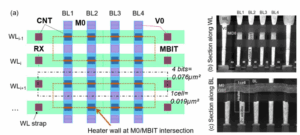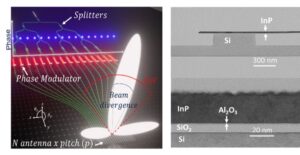ST submitted four papers at the latest IEEE International Electron Devices Meeting (IEDM 2021). One of them resulted from an invitation by the organizers, while another is the fruit of a collaboration with Samsung. All of them aim to make industry-changing innovations more accessible. Indeed, Samsung and ST showed the first 18 nm FDSOI microcontroller thanks to new processes. Similarly, the other papers look to make sensors or memories more cost-effective in the next few years. Let us, therefore, dive into some of the papers ST showcased at the event.
“1.62μm Global Shutter Quantum Dot Image Sensor Optimized for Near and Shortwave Infrared”
What’s New at IEDM 2021?

One of the showstoppers was a paper led by Johnathan Steckel on the first 1.62 µm pixel pitch global shutter image sensor for near-infrared (NIR) and shortwave infrared (SWIR) produced on a 300 mm silicon wafer. Using lead sulfide quantum dots, the image sensor is significantly more cost-effective than indium gallium arsenide (InGaAs) alternatives. Additionally, it’s a global shutter technology with a record-breaking small pixel pitch and excellent efficiency. It is thus possible to capture more details in the infrared portion of the spectrum. As a result, the paper creates new opportunities for mobile devices, machine vision, hyperspectral imaging and spectroscopy, security, and surveillance.
Why Quantum Dots?
Quantum dots are tiny (between 2 nm to 20 nm usually) semiconductor crystals. One of their unique properties is that their optical and electrical properties change with their size. In an image sensor, using quantum dots of various sizes makes it possible to capture different wavelengths of light beyond silicon’s absorption limitations. In ST’s IEDM 2021 paper, researchers tuned quantum dots to capture 940 nm and 1400 nm light, the latter rivaling InGaAs sensors. However, InGaAs imaging devices are challenging and costly to make. Using a conventional 300 mm silicon wafer process in existing fabs, ST can produce the quantum dot sensor for shortwave infrared at a fraction of the cost.
Why IEDM 2021 and Not Years Ago?

Quantum dots are not new, and scientists were already studying their properties in the early 1980s1. However, it took years to colloidally synthesize crystals that could absorb infrared light and to create thin-film devices and fabrication processes that would yield the performance and stability necessary for real-world applications. More specifically, ST developed a manufacturing process that would not exceed 150ºC while also creating lithographic methodologies that would preserve the quantum dot’s integrity.
The IEDM 2021 paper explains in detail how ST created this image sensor technology on 300 mm wafers and describes the performance and reliability achieved to date. We plan to provide samples and evaluation kits to potential customers in 2022 and move to mass production in the coming years. Among the potential applications, mobile devices could use the new sensors to improve facial or object detection. Ultimately, a low-cost high-volume SWIR image sensor accessible to all consumers will open the door to new use-cases and applications.
Innovations in the Future Automobiles
“Heater system optimization for robust ePCM reliability and scalability in 28nm FDSOI technology”

Another paper, led by Rossella Ranica, looks at the impact of the Heater system in embedded phase-change memory (ePCM) on endurance and retention. As we already explained, PCM uses a chalcogenide compound that changes states thanks to a heating element. However, there’s still a lot to learn about the impact of various heater values on cells’ endurance and reliability. The paper is thus crucial because it shows how the Heater resistance impacts both. A higher Heater resistance will lead to a lower current and greater endurance, but it will reduce the number of recrystallized cells. Thanks to those findings, automotive microcontrollers with ePCM can better manage this trade-off and fine-tune the Heater system.
“Silicon Photonics Beyond Optical Interconnects”
 Left: Operation principle of an OPA. An array of N antenna forming an N.p aperture is creating a beam by constructive interferences. The azimuth angle is determined by each antenna phase. The field of view is determined by the +/- 1 order interference, Right: TEM cross-section of the hybrid InP/Si waveguide
Left: Operation principle of an OPA. An array of N antenna forming an N.p aperture is creating a beam by constructive interferences. The azimuth angle is determined by each antenna phase. The field of view is determined by the +/- 1 order interference, Right: TEM cross-section of the hybrid InP/Si waveguideIEDM 2021 also invited an ST paper led by Frederic Boeuf to explore silicon photonics in other applications than communication, such as an optical phased array (OPA) and a neuromorphic accelerator. Instead of traditional LiDAR devices, which use mechanical sensors, ST can envision creating a component with no moving parts. Traditional silicon photonics devices can already perform laser beam scanning and shaping to detect a subject’s presence and range. However, high power consumption represents a significant problem when implementing the technology in consumer electronics.
Rather than the classic thermo-optical devices, the paper discusses the use of an electro-optical modulator, including Si-PiN diodes and hybrid III-V/Si devices. As a result, the paper lays out a more robust, efficient, and cost-effective LiDAR solution. Current industry roadmaps put the launch of such devices at about 2025. Additionally, in collaboration with the University of Tokyo, the paper discusses how hybrid III-V/Si devices could benefit Si-photonics-based neural networks. Indeed, by enabling low-power multiplication and addition operations at the speed of light, silicon photonics could transform neuromorphic computations.
Authors and Papers at IEDM 2021
- Johnathan Steckel, 1.62µm Global Shutter Quantum Dot Image Sensor Optimized for Near and Shortwave Infrared
- Rossella Ranica, Heater system optimization for robust ePCM reliability and scalability in 28nm FDSOI technology
- Frederic Boeuf, Silicon Photonics Beyond Optical Interconnects
- Collaboration between ST and Samsung, 18nm FDSOI Technology Platform embedding PCM & Innovative Continuous-Active Construct Enhancing Performance for Leading-Edge MCU Applications
- Rossetti, R., Nakahara, S. & Brus, L. E. Quantum size effects in the redox potentials, resonance Raman spectra, and electronic spectra of CdS crystallites in aqueous solution. J. Chem. Phys.79, 1086–1088 (1983). ↩
